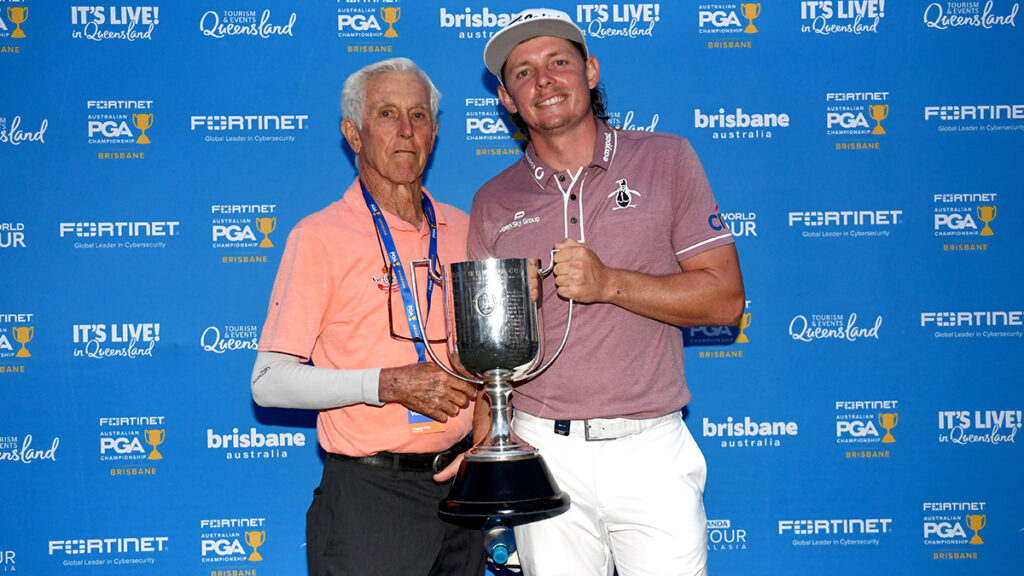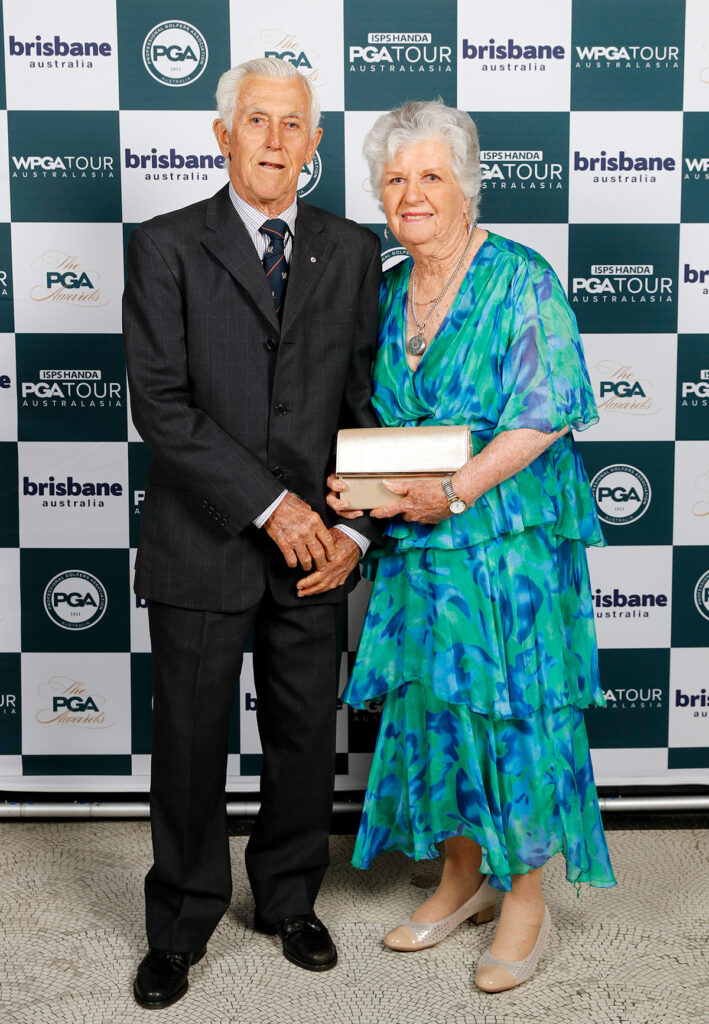
As he celebrates 70 years as a member of the PGA of Australia, this is the unlikely story of Charlie Earp becoming one of the most influential figures in Australian golf.
Scan the annals of world sport and the most celebrated coaches are rarely those with the most complicated playbooks. They understand people. They know how to reach that place within a person that both instils belief and dares them to push for better. Charlie Earp is best known for being Greg Norman’s coach in his formative years, when the Great White Shark’s teeth were only just starting to come in. Yet Earp’s legacy to Australian golf lies within the countless thousands of people he guided in 45 years as the head professional at Royal Queensland Golf Club who were simply chasing more Stableford points on a Saturday.
One of only four people to be honoured as a PGA Immortal, Earp reflects on 70 years of trying to help Aussie golfers love the game just a little bit more.

▶ ▶ ▶
Those 70 years went past so fast, I haven’t really had a chance to ever think about it. When I do sit down and think about what it’s meant to me, from the time that I started to what it is today, there’s been a magnificent change in the game.
▶ ▶ ▶
All the battling that we did to get people to play golf. Young people. It’s just amazing what has happened in this respect. It’s rewarding for me to see all that work we did in the ’50s and ’60s to see somebody playing the game and enjoying the game. My predecessors in this country and throughout the world did a magnificent, magnificent job for the results we have today.
▶ ▶ ▶
The second day that I set foot on a golf course was my first day of work to become an assistant professional under Reg Want, who was the professional at Coolangatta & Tweed Heads Golf Club.
▶ ▶ ▶
It was explained to me by my boss that you’re a professional, and you carry yourself like a professional because you are the backbone of the club. When the people first come in, you’re the guy they’re going to see. And you’re the guy they’re going to see after they finish their game.
▶ ▶ ▶
I used to ride horses a fair bit on our dairy farm and the co-ordination I learnt to work with the horse – not the horse work with me – helped in understanding what Reg was talking about with regards to the golf swing. It’s about finding the swing that suits them − for their body. There’s not two people in the world who swing the club the same. They’re all built differently, so you have to design a swing based on what they’ve got to work with.

▶ ▶ ▶
The most important thing to me was to work on a pace. To get people to slow their swing down, you’ve got to find something for them to do. I would tell people that it’s like starting an outboard motor on a dinghy. You can pull it with your right hand and do it as quick as anything, because you’re trying to crank it over. Now do the same thing with your left hand and you can’t do it as fast. I used to get right-handed players to push the club back with their left arm. That would slow them down to a pace that suits them.
▶ ▶ ▶
I went away to play tournaments to learn more as a golf teacher. I used to go to the practice fairway and watch. Gary [Player] was only a young bloke, Arnold [Palmer] was only young and Jack Nicklaus was yet to come on the scene then. I’d run into somebody, maybe Peter Thomson or Kel [Nagle], Frank Phillips or Billy Dunk. I’d hear them talking and I used to watch their swings and see what made them tick. I’d just say, “Well, that’ll come in handy because I’ve got a vision of those swings that I still have in my mind now.”
▶ ▶ ▶
I can recall Reg saying, “Hey, Gary Player, he won’t be any good. He swings the club too flat.” I said to him a couple of years later, “Boss, I’ll tell you what, that Gary Player’s not going too bad with that flat swing.”
▶ ▶ ▶
Norman Von Nida paved the way, a bit like Joe Kirkwood. I think he had 67 or 68 tournaments that he won over the years and he went over [to Europe] without a pound to his name. He paved the way. I admired him so much for what he was capable of doing. He wasn’t a very big man but pretty strong in the arms and the legs. He set a great example. Always dressed very nicely, and he thanked Walter Hagen for that.
▶ ▶ ▶
I really think the person who deserves more credit for what he’s done in the world of golf is Joe Kirkwood. He went overseas to America and he teed up with Walter Hagen, and Joe Kirkwood was a big part of where the golf tour is today. The PGA of Australia is very lucky to have a person of that calibre to name our PGA Championship after. He deserves more media, more respect.
▶ ▶ ▶
Vince Gair was the premier of Queensland and he wanted to put wharves all over where Royal Queensland is. There was a bust-up in the Labor Party and Frank Nicklin took over as premier. They decided they wanted to resurrect ‘RQ’ and so they got a new secretary-manager and a new pro. They asked Reg if he would go back, but he was settled in Coolangatta – his kids were going to school down there. He asked if he could recommend somebody and he recommended me. I was 20 years old when I took over in 1958.
▶ ▶ ▶

When I first started at Royal Queensland, I wasn’t allowed in the clubhouse to have a drink or anything. You’d go out the back to be able to get a drink. I think we were the first golf club in the Commonwealth to allow the professional into the bar.
▶ ▶ ▶
I never seriously thought of leaving RQ in the 45 years that followed. Some of the guys asked me to go to Royal Sydney after Alex [Mercer] had finished there, but they’ve been good to me. They’ve looked after me and been wonderful all the way through. It’s a wonderful club.
▶ ▶ ▶
People who come along for a lesson, they don’t want to play the tour; they just want to hit the ball better. They just want to enjoy the game of golf. You give them a swing or give them the feeling or explain to them what the swing is all about.
▶ ▶ ▶
Greg [Norman] was so easy to teach. He was already a good golfer. I’d see him and might only say a few words while he was hitting balls. The good players are all easy to teach; it’s just finding out the solution that’s going to help them to get the result they want.
▶ ▶ ▶
The story of Greg hitting a ball over the Gateway Bridge is absolutely true. Excuse me for dropping names, but [Federal politician] Sir James Killen was with us. I said to Greg, “Do you reckon you could hit a ball over that bridge?” He said, “Yeah, no problem.” We went back to where the original tee was for the 12th and he hit six balls, three over and three under. And they were still rising as they went over the bridge. The gantry was still working, building the bridge, and so there’s the bridge and then the gantry on top of that, and he hit them over the gantry.

▶ ▶ ▶
Corinne Dibnah had a silky swing. She won a British Open and a European Open.
▶ ▶ ▶
I never got to see Ben Hogan. One of my wishes in life was to see Ben Hogan and meet Ben Hogan but I never met him.
▶ ▶ ▶
Karrie [Webb] used to come down here and come away on a couple of state trips with us. She had ‘mongrel’. She was determined. I don’t know where she picked it up from – it might have been born in her – but her attitude was that ‘this is my tournament and you’re not going to take it away from me’.
▶ ▶ ▶
The hardest shot in golf is different for everybody. To me, mine would be chipping. Dear old Von (Norman Von Nida), he was giving me advice when I was a kid, and I misinterpreted what he said and I overcooked it. One year at the Masters, Byron Nelson was hitting the first tee shot and his hands were shaking. He said, “I’m going to have to give this away, my nerves are not good enough for this.” He was the greatest player on the planet at one stage.
▶ ▶ ▶
It never felt like a job; it felt like a pleasure to me. To be doing something you like and something you love, what more do you want in life? Helping people to enjoy themselves. Couldn’t get anything better than that.
Photos courtesy of PGA Australia

